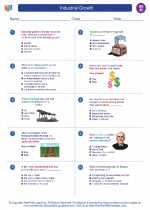Industrial Growth
After the Civil War and Reconstruction, the United States began to see a rise in industry and the growth of businesses. The Transcontinental Railroad, the first railroad to span the United States from Atlantic to Pacific, opened up the opportunity for social and economical growth towards the West. Read More...
◂Social Studies Worksheets and Study Guides Eighth Grade. Industrial Growth
Study Guide Industrial Growth
Industrial Growth  Worksheet/Answer key
Worksheet/Answer key Industrial Growth
Industrial Growth  Worksheet/Answer key
Worksheet/Answer key Industrial Growth
Industrial Growth  Worksheet/Answer key
Worksheet/Answer key Industrial Growth
Industrial Growth 

 Worksheet/Answer key
Worksheet/Answer key
 Worksheet/Answer key
Worksheet/Answer key
 Worksheet/Answer key
Worksheet/Answer key

The resources above cover the following skills:
National Standards for Civics and Government (NSCG)
What are the roles of the citizen in American democracy? How can citizens take part in civic life?
Forms of political participation. Students should be able to describe the means by which Americans can monitor and influence politics and government. To achieve this standard, students should be able to
Describe historical and current examples of citizen movements seeking to promote individual rights and the common good, e.g., abolition, suffrage, labor and civil rights movements
National Content Standards in Economics (NCSE)
Institutions
Students will understand that institutions evolve and are created to help individuals and groups accomplish their goals. Banks, labor unions, markets, corporations, legal systems, and not-for-profit organizations are examples of important institutions. A different kind of institution, clearly defined and enforced property rights, is essential to a market economy. Students will be able to use this knowledge to describe the roles of various economic institutions and explain the importance of property rights in a market economy.
At the completion of Grade 8, students will use this knowledge to:
Read about the establishment of a labor union and explain why it emerged, how it influenced the U.S. economy, and what procedures it used to gain benefits for its members and workers in general.
National Center for History in Schools (NCHS)
Historical Thinking Standards
Historical Comprehension
Reconstruct the literal meaning of a historical passage.
United States History Content Standards
Era 4: Expansion and Reform (1801-1861)
How the industrial revolution, increasing immigration, the rapid expansion of slavery, and the westward movement changed the lives of Americans and led toward regional tensions.
The student understands how the factory system and the transportation and market revolutions shaped regional patterns of economic development.
Era 6: The Development of the Industrial United States (1870-1900)
How the rise of corporations, heavy industry, and mechanized farming transformed the American people.
The student understands the connections among industrialization, the advent of the modern corporation, and material well-being.
Massive immigration after 1870 and how new social patterns, conflicts, and ideas of national unity developed amid growing cultural diversity.
The student understands how new cultural movements at different social levels affected American life.
The rise of the American labor movement and how political issues reflected social and economic changes.
The student understands the rise of national labor unions and the role of state and federal governments in labor conflicts.
Era 7: The Emergence of Modern America (1890-1930)
How Progressives and others addressed problems of industrial capitalism, urbanization, and political corruption.
The student understands the origin of the Progressives and the coalitions they formed to deal with issues at the local and state levels.
World History Content Standards
Era 7: An Age of Revolutions, 1750-1914
Patterns of nationalism, state-building, and social reform in Europe and the Americas, 1830-1914.
The student understands the political, economic, and social transformations in the Americas in the 19th century.
Patterns of global change in the era of Western military and economic domination, 1800-1914.
The student understands connections between major developments in science and technology and the growth of industrial economy and society.
Major global trends from 1750-1914.
The student understands major global trends from 1750 to 1914.
Era 8: A Half-Century of Crisis and Achievement, 1900-1945
Reform, revolution, and social change in the world economy of the early century.
The student understands the world industrial economy emerging in the early 20th century.